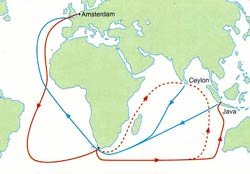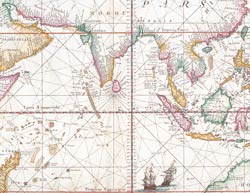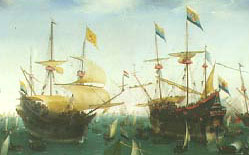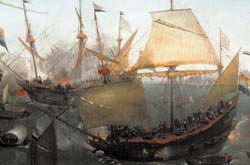 |
|
Maritime
Lanka |
1 Jan 2002
|
|||
| Last modified: 1 Jan 2002 |
 |
 |
For the Dutch East India Company (VOC), Galle was a key trading hub, second only to Batavia. The warehouses were packed with trade items from all parts of Asia. Fleets of ships came to Galle each year for trade, supplies, and repairs. Evidence of the complex organization behind these maritime activities is to be found in the many surviving Dutch buildings in Galle, the extensive historical archives in Colombo and the Netherlands, and the wrecks of five Dutch East Indiamen in the Bay of Galle.
Galle was also an important staging post. Some ships sailed directly between the Netherlands and Batavia, but others stopped at Galle. The larger VOC ships called only during the NE monsoon (Oct-April). Smaller vessels could also use the harbour during the SE monsoon, although the seas are then rougher.
Ships normally arrived from the Netherlands in October-November, before going on to Batavia. They left Sri Lanka for the Netherlands either in November or in February. The timing was partly to take advantage of favourable trade winds, but the ships also travelled in convoy for self-defence.
Important trade items included textiles, pepper and yarn from South India; cinnamon, cardamon, pearls, gems, and elephants from Sri Lanka. Some of the local products were exported only short distances (eg elephants from Sri Lanka to India), while others travelled further afield. Textiles were important in the trade to other parts of Asia, while most of the cinnamon was exported to Europe. The VOC were active in all of these trades, with an appropriate variety of ship types - as can be seen in the wrecks in Galle harbour.
 The
largest ships in service were the so-called ‘return-ships’ (retourschepen),
designed for the lengthy voyage between Europe and Asia. These ships were usually
of 500-1100 tons. Some of these ships sailed directly from Galle to Europe with
a cargo of goods such as cinnamon, cardamon coffee, and pepper from Sri Lanka,
and textile, yarns and pepper from India. Other ships stopped at Galle on their
way to and from Batavia. Two return-ships, the Barbesteijn
(1735) and the Geinwens (1775), were
wrecked in the bay of Galle.
The
largest ships in service were the so-called ‘return-ships’ (retourschepen),
designed for the lengthy voyage between Europe and Asia. These ships were usually
of 500-1100 tons. Some of these ships sailed directly from Galle to Europe with
a cargo of goods such as cinnamon, cardamon coffee, and pepper from Sri Lanka,
and textile, yarns and pepper from India. Other ships stopped at Galle on their
way to and from Batavia. Two return-ships, the Barbesteijn
(1735) and the Geinwens (1775), were
wrecked in the bay of Galle.
When the Dutch first came to Asia, all of their ships made the long and dangerous voyage from Europe and back, but this was soon replaced by a 'hub-and-spoke' system. The Dutch captured Jacatra on Java in 1619, renamed it Batavia, and made it the hub of their Asian trade. Small ships were despatched to trading ports all over Asia, and the cargo they brought to the central storehouse was conveyed to Europe by large 'return-ships'.
During the VOC's first fifty years, it developed types of ship suitable for the different trading areas, depending on the cargo, the ports involved, and sea conditions. A class of 'yachts' was designed for Asia. Their evolution may be tracked in the Resolutions of the Directors in the Netherlands. As early as 1611 a specially-appointed commission recommended the use of small fast ships with three decks. Following this advice, a ship came into use with the following dimensions: length 104 voet, width 26 voet, height 13.5 voet(1). The 'yachts' were of medium size, 2-300 tons. They were small enough to reach most Asian harbours, but big enough for a journey to Europe if necessary. Ageing return-ships were also retired to Asian routes when no longer seaworthy for the long voyage, but their size was a limitation, as many trading posts were in rivers or on shallow coasts.
 There
are two wrecks in Galle of ships specially built for the Asian trade. The Hercules
was wrecked in 1661 as she departed with a cargo for Batavia, and the Dolfijn
was lost two years later on arrival from Surat.
There
are two wrecks in Galle of ships specially built for the Asian trade. The Hercules
was wrecked in 1661 as she departed with a cargo for Batavia, and the Dolfijn
was lost two years later on arrival from Surat.
The Avondster, in contrast, was a modified English ship, and had made several trips between Europe and Asia before being 'retired' to the Asian routes.
The Hercules was built in 1655 at Zaandam, the shipbuilding centre ten miles north of Amsterdam, where Tsar Peter the Great enrolled as a carpenter forty-two years later to study Dutch shipbuilding techniques. Yachts sailing to India had become significantly bigger than their predecessors, and were more heavily armed: in 1655 the Dutch were blockading the Portuguese fort at Goa. We know from the archives that the dimensions of the Hercules were: length 140 voet, width 33 voet, height 14.5 voet, with the space between first and second decks measuring 7.5 voet. She cost 25,150 guilders. On the wreck site, we have found 31 iron guns, which would usually have been more than expected for a ship of this size - but a list of the ships operating in Sri Lanka in 1657, found in the Dutch records in Colombo, also shows a picture of heavily armed vessels. It is clear that the VOC followed a flexible policy on ship armaments, and added additional guns for areas where enemies were active.
Smaller ships were required to transport goods from production areas to the trading hubs. Some local vessels such as dhoni were used, some smaller ships like sloops were built, and some older and less seaworthy yachts were moved to the shorter routes. At an even more local level, the Dutch built a network of canals in Sri Lanka for inland transport.
| Maritime Lanka homepage | Using Galle harbour |